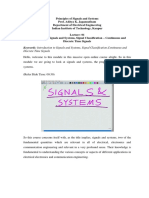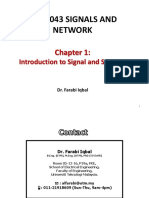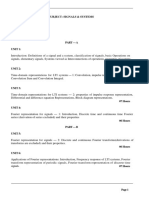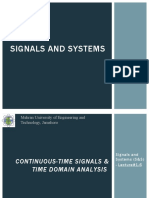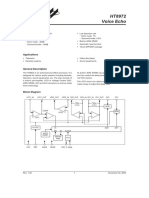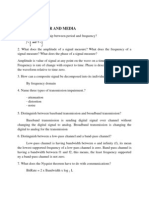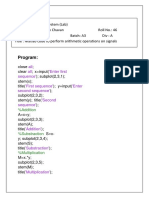Signals and Systems
Signal and System
For the elitech program
Lecturer: MS. Đào Lê Thu Thảo
Faculty of Electronic Engineering
Thao.daolethu@hust.edu.vn
3
�Reference book:
Signals and Systems
Alan V.Oppenheim – Willsky, Prentice Hall.
4
� Phylosophy
• Practically everything around us can be thought of as either a
signal or a system.
→ signals and interaction with system
• In Electrical and electronic field, subject of signal and system is a
fundamental foundation of all advanced engineering analysis
• 2 ways of looking at the world:
time domain >< frequency domain = deeply intertwined
→ Present a variety of tools and techniques to analysis
5
� Introduction of subject
• Chapter 1: introduction of signals and systems in general - time domain – for
both cases: continuous time and discrete time. Then, we introduce the mathematical
representation and how to compute them. Some discussion of singularity functions –
to mathematically describe signal and systems in time domain.
• Chapter 2: present a powerful alternative method to analysis the signals and
systems. Systems often become much easier to analyze by expressing the input as
functions of frequency rather than time. In this chapter, we study how to write a
signal as a function of frequency, the relationship of time domain and frequency
domain, how to determine which domain is best suited for a particular problem .
• Chapter 3, 4: the Laplace and Z-transformation are presented as powerful
techniques to analyze and synthesis the systems in continuous-time and discreted-
time, respectively.
6
� Chapter 1: Signals and Systems in time domain
1.1. Definition:
Signals: an abstraction of any measurable quantity of one or more
independent variables such as time or space.
Systems: an abstraction of anything that take an input signal, operates on
it, and produces an output signal.
x y
System
• In scope of subject, we study a two-dimension signal of one variable of time and their
system that established the relationship between its input and output
7
� Chapter 1: Signals and Systems in time domain
• 1.2. Classification of signal:
• Multi-variable signal and One-variable signal
• Continuous-time signal and Discrete-time signal
• The discrete-time signals are often sampled versions of continuous-time signals
8
� Chapter 1: Signals and Systems in time domain
• 1.2. Classification of signal:
• Determine signal and Random signal
• Determine signal can be expressed by some mathematical functions of time
• Random signal only can be expressed by the distributed functions that tell us ability to happen
the signals in time.
• Periodic signal and non-periodic (aperiodic) signal
• x(t) = x(t – kT) T = fundamental period
→ sinusoidal signal
9
� Chapter 1: Signals and Systems in time domain
• 1.3. Representation of signal:
• Mathematical function
• Determine signal can be expressed by some mathematical functions of time
Example: x(t) = 2.sin(300t+Pi/2)
1 𝑡≥0
𝑥 𝑡 =ቊ
−1 𝑡 < 0
10
� Chapter 1: Signals and Systems in time domain
• 1.3. Representation of signal:
• Graphical representation
The discrete-time
signal is defined
only for integer
value of time
11
� Chapter 1: Signals and Systems in time domain
X(t)
• 1.3. Representation of signal:
• Discontinuous-time listing
2
f1(t)
index n=0,
rather
than time t
t1 t2 t3
f2(t) -1
• Listing value of x[n] = { … 1, 2, 0, 3, …}
x[-1]=1 x[2]=3
n
-2 -1 0 1 2 3
12
� Chapter 1: Signals and Systems in time domain
• 1.4. Energy and Power signal:
• Continuous-time signal:
• The instant power: 𝑃𝑥 𝑡 = 𝑥(𝑡) 2
𝑇/2 ∞
• The total energy: 𝐸𝑥 = lim −𝑇/2 𝑥(𝑡) 2 𝑑𝑡 = −∞ 𝑥(𝑡) 2 𝑑𝑡
𝑇→∞
1 𝑇/2
• The average power: 𝑃𝑥 = . −𝑇/2 𝑥(𝑡) 2 𝑑𝑡
𝑇
13
� Chapter 1: Signals and Systems in time domain
• 1.4. Energy and Power signal:
• Discrete-time signal:
• The total energy: 𝐸𝑥 = σ∞
−∞ 𝑥[𝑛]
2
1 𝑁
• The average power: 𝑃𝑥 = . 𝑥[𝑛] 2 𝑑𝑡
2𝑁+1 −𝑁
14
� Chapter 1: Signals and Systems in time domain
• 1.5. Operation:
• Execute in Amplitude axis: combination, ratio, multiplication
• Execute in Time axis == transformation of independent variable
• Time shift = unchanged the shape of origin signal
• Time scaling = shrinking or stretching of time
Time shifting Time reversal Time scaling
= = =
Delay and Advancing Reflect/symetry to vertical axis Shrinking and stretching
15
� Chapter 1: Signals and Systems in time domain
• 1.6. Basic functions: Exponential function and sinusoidal function
• Important : they play as basic building blocks from which we construct many other signals
• Real exponential signal:
𝑥 𝑡 = 𝐾. 𝑒 −𝛼𝑡 K, α : real number.
• Periodic complex exponential and sinusoidal functions
2𝑘𝜋
𝑒 𝑗𝜔0 𝑡 = 𝑒 𝑗𝜔0 (𝑡+𝑇) 𝑇 =
𝜔0
𝑥 𝑡 = 𝐴. sin 𝜔0 𝑡 + 𝜙
Euler’s relation:
𝒆𝒋𝝎𝟎 𝒕 = 𝐜𝐨𝐬 𝝎𝟎 𝒕 + 𝒋. 𝐬𝐢𝐧(𝝎𝟎 𝒕)
𝒆𝒋𝒙 +𝒆−𝒋𝒙 𝒆𝒋𝒙 −𝒆−𝒋𝒙
𝒄𝒐𝒔𝒙 = 𝐬𝐢𝐧𝒙 =
𝟐 𝟐𝒋
16
� Chapter 1: Signals and Systems in time domain
• 1.6. Basic functions: Exponential function
• The exponential signal of real factor.
17
� Chapter 1: Signals
and Systems in
time domain
• 1.6. Basic functions:
Exponential function and
sinusoidal function
• Discrete-time signal:
𝑥[𝑛] = 𝐾. 𝑒 𝛽𝑛
• In term of sinusoidal
function:
𝑥[𝑛] = 𝐴. cos 𝜔0 . 𝑛
• Is that periodic function?
18
� Chapter 1: Signals and Systems in time domain
• 1.6. Basic functions: Sinusoidal function
19
� Chapter 1: Signals and Systems in time domain
• 1.6. Basic functions: Exponential function and sinusoidal function
• General complex exponential signal:
𝑥 𝑡 = 𝐶. 𝑒 𝑠.𝑡
𝐶 = 𝐶 . 𝑒 𝑗𝜃 and s = 𝑟 + 𝑗𝜔0
Then,
𝐶. 𝑒 𝑠.𝑡 = 𝐶 . 𝑒 𝑗𝜃 . 𝑒 𝑟𝑡+𝑗𝜔0 𝑡 = 𝐶 . 𝑒 𝑟𝑡 . 𝑒 𝑗(𝜔0 𝑡+𝜃)
= 𝐶 . 𝑒 𝑟𝑡 . cos 𝜔0 𝑡 + 𝜃 + 𝑗. 𝐶 . 𝑒 𝑟𝑡 . sin 𝜔0 𝑡 + 𝜃
Sketch the exponential oscillatory? Frequency and envelope of curve?
20
� Chapter 1: Signals and Systems in time domain
• 1.6. Basic functions: Exponential function and sinusoidal function
• General complex exponential signal:
• x(t) = es.t s is a complex factor
s is distributed in s-plane
21
�Chapter 1: Signals
and Systems in
time domain
• 1.6. Basic functions: Exponential
function and sinusoidal function
• General Complex Exponential
𝐶. 𝑒 𝑧.𝑛 = 𝐶 . 𝑒 𝑗𝜃 . ( 𝛼 . 𝑒 𝑗𝜔0 )𝑛 =
= 𝐶 . 𝛼 𝑛 . cos 𝜔0 𝑛 + 𝜃 +
𝑗. 𝐶 . 𝛼 𝑛 . sin 𝜔0 𝑛 + 𝜃
22
� Chapter 1: Signals and Systems in time domain
• 1.7. Generalized functions:
• Properties of the impulse, unit step function and their relationship:
𝑥 𝑡 . 𝛿(𝑡 − 𝑡0 ) Multiplying by a δ(t) products an impulse with area given by the height of function at
location of Dirac = sampling x(t) at t0.
1 Time scaling an impulse is the same as changing its area
𝛿 𝑎. 𝑡 = 𝛿(𝑡)
|𝑎|
𝑡 u(t) is distribution of Dirac function when it travel all time axis
𝑢 𝑡 = න 𝛿 𝜏 . 𝑑𝜏
−∞
𝑑 Dirac is the derivative of unit step function
𝛿(𝑡) = 𝑢(𝑡)
𝑑𝑡
23
� Chapter 1: Signals and Systems in time domain
• 1.8. System:
CT system
DT system
24
� Chapter 1: Signals and Systems in time domain
• 1.8. Interconnection of Systems:
25
� Chapter 1: Signals and Systems in time domain
• 1.8. Interconnection of Systems:
Example:
26
� Chapter 1: Signals and Systems in time domain
• 1.9. Properties of Systems:
a. System with and without memory
• Memoryless: if its output for each value of the independent variable at a given
time is dependent only on the input at the same time.
Example:
27
� Chapter 1: Signals and Systems in time domain
• 1.9. Properties of Systems:
b. Causality
• A cause system if the output at any time depends only on value of the input at the
present time and in the past.
Example:
28
� Chapter 1: Signals and Systems in time domain
• 1.9. Properties of Systems:
c. Stability
• A stable system is one in which small inputs lead to responses that do not diverge.
BIBO system:
If 𝑡∀ ∞ < 𝑡𝑑 )𝑡(𝑥 lead to a response 𝑡∀ ∞ < 𝑡𝑑 )𝑡(𝑦
Example:
29
� Chapter 1: Signals and Systems in time domain
• 1.9. Properties of Systems:
d. Linearity
• In a linear system if an input consists of the weighted sum of several signals, then
the output is the superposition.
Example:
30
� Chapter 1: Signals and Systems in time domain
• 1.9. Properties of Systems:
e. Invertibility and inverse system
• A system can be invertible if it exists an inverse system that can fully recover the
original signal.
Example:
31
�THANK YOU !
32










